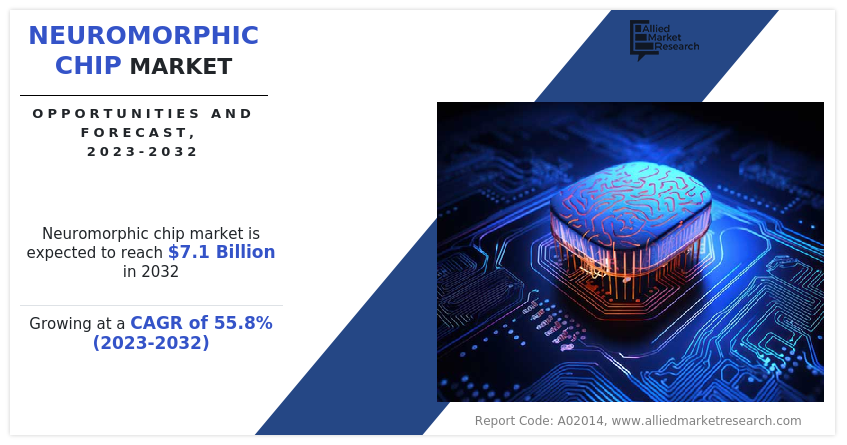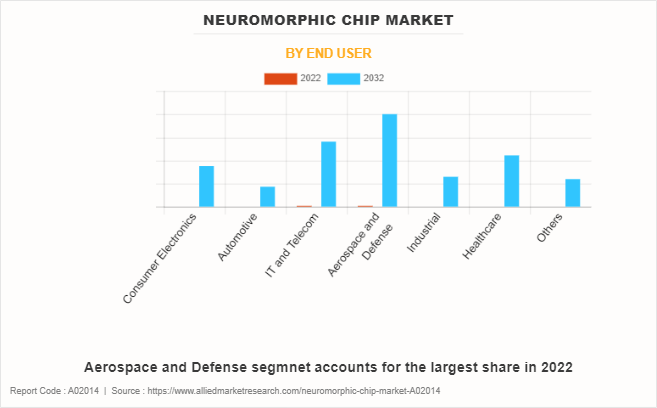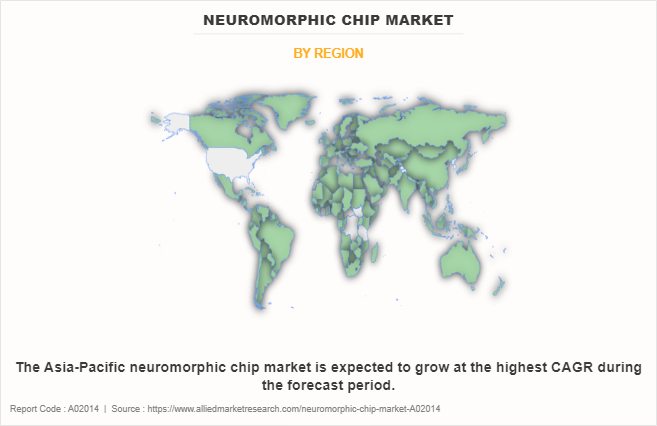Neuromorphic Chip Market Research, 2032
The Global Neuromorphic Chip Market was valued at $87.9 million in 2022, and is projected to reach $7.1 billion by 2032, growing at a CAGR of 55.8% from 2023 to 2032.
Neuromorphic chips are specialized microprocessors that are designed to mimic the architecture and operation of the human brain. These chips process information in a highly parallel and energy-efficient manner by utilizing artificial neurons and synapses in a network. Neuromorphic chip are used in applications such as machine learning, robotics, and cognitive computing, particularly for tasks involving pattern recognition, sensory perception, and decision-making. Neuromorphic chips emulate the neural structure of the brain, offering potential advantages in efficiency and computing power for tasks that require complex, real-time processing and adaptability.

Segment Overview
The neuromorphic chip market is segmented into end user and region.

On the basis of end user, the market is classified into consumer electronics, automotive, IT and telecom, aerospace and defense, industrial, healthcare and others. In 2022, the aerospace and defense segment dominated the neuromorphic chip market size in terms of revenue and is expected to follow the same trend during the forecast period. Moreover, the consumer electronics segment is expected to grow at a high CAGR during the period of 2023-2032.

By region, it is analyzed across North America (the U.S., Canada, and Mexico), Europe (UK, Germany, France, Italy, and the rest of Europe), Asia-Pacific (China, Japan, India, South Korea, Taiwan, and the rest of Asia-Pacific), and LAMEA (Latin America, the Middle East, and Africa). North America, Specifically U.S., remains a significant participant in the neuromorphic chip market. Major organizations and government institutions in the North America region have significantly put resources into action to develop enhanced Neuromorphic chip which is driving the growth of the neuromorphic chip industry in North America region.
Neuromorphic chips are highly energy-efficient, making them suitable for battery-powered devices and edge computing. They can process data with minimal power consumption, leading to longer device battery life and reduced energy costs in data centers. These chips excel at processing data in real-time, allowing for quick decision making and responses. This is crucial for applications where immediate actions or responses are necessary, such as autonomous vehicles and robotics. The primary aim of neuromorphic chips is to improve the efficiency of AI systems, especially in environments with limited resources, by utilizing the energy-efficient principles of the human brain. Unlike conventional digital processors, neuromorphic chips utilize spiking neural networks to process information, enabling energy-efficient and real-time data analysis for applications such as image and speech recognition, robotics, and autonomous vehicles. In addition, they main aim is to equip AI systems with cognitive capabilities, including adaptive learning and pattern recognition, enabling them to make more context-aware and intelligent decisions. These chips not only offer practical advantages in AI but also serve as valuable tools for neuroscientists to deepen their understanding of how the human brain functions.
The surge in demand for wearable devices is one of the prominent drivers for neuromorphic chip market growth. Innovations in the telecommunication industry, IT sector, artificial intelligence, and aerospace and defense sector have paved the way for devices which are based on neuromorphic chips. Furthermore, neuromorphic chips are also beneficial in casino gaming applications. For instance, BrainChip Holdings’ partnership with Gaming Partners International and SNTech is expected to drive the growth of the neuromorphic computing market. High cost of manufacturing neuromorphic chips may slow down their market penetration and adoption in industries that are cost-sensitive, limiting the growth of the market. This financial barrier may limit the market participation of numerous stakeholders and decrease the pace of innovation, causing difficulties for potential users.
In addition, the global market is being driven by significant growth in the information technology (IT) industry. Continuous technological advancements in the sector also contribute to the market's growth. For example, the combination of artificial intelligence (AI), the Internet of Things (IoT), and advanced analytics, with these chips has boosted market growth globally.
The neuromorphic chip market is segmented into end user, and region. By end user, the market is classified into consumer electronics, automotive, IT and telecom, aerospace and defense, industrial, healthcare and others. In 2022, the aerospace and defense segment dominated the market in terms of revenue and is expected to follow the same trend during the forecast period. Moreover, the consumer electronics segment is expected to grow at a high CAGR during the period of 2023-2032.
Competitive analysis and profiles of the major neuromorphic chip market players, such as IBM Corporation, HRL Laboratories, LLC, SynSense, General Vision Inc., GrAI Matter Labs, SK HYNIX INC., QUALCOMM Incorporated, BrainChip, Inc, Samsung Electronics Co. Ltd and Intel Corporation are provided in this report. Product launch, agreement, partnership, and acquisition business strategies were adopted by the major market players in 2022.
Competition Analysis
Competitive analysis and profiles of the major neuromorphic chip market players, such as IBM Corporation, HRL Laboratories, LLC, SynSense, General Vision Inc., GrAI Matter Labs, SK HYNIX INC., QUALCOMM Incorporated, BrainChip, Inc, Samsung Electronics Co. Ltd and Intel Corporation is provided in this report.
Country Analysis
North America-wise, the U.S. acquired a prime share in the Neuromorphic chip market in the North American region and is expected to grow at a CAGR of 56.22% during the forecast period of 2023-2032. The U.S. holds a dominant position in the Neuromorphic chip market, owing to the strong presence of aerospace, defense, IT and telecommunication, and other industries. Technological breakthroughs have assisted in the advancement of new x-ray tubes, which can make the overall process more efficient and significantly improve accuracy in various applications.
In Europe, the Rest of Europe dominated the Europe Neuromorphic chip market share in terms of revenue in 2022 and is expected to follow the same trend during the forecast period. Furthermore, the France is expected to emerge as one of the fastest growing countries in Europe's Neuromorphic chip industry with a CAGR of 57.33%, owing to the rise in the demand of automotive and IT and telecommunication across the region.
In Asia-Pacific, China holds a dominated market share in Asia-Pacific region and is expected to follow the same trend during the forecast period, owing to IT and Telecommunication. However, India is expected to emerge as a highest CAGR in Neuromorphic chip market Asia-Pacific in this region.
In LAMEA, Latin America is growing the fastest in the Neuromorphic chip market because of its growing economy, increasing disposable income, and ongoing expansion of telecommunications infrastructure throughout the area. Moreover, the Middle East region is expected to grow at a high CAGR of 55.03% from 2023 to 2032, owing to its economic growth and investment in consumer electronics.
Top Impacting Factors
The neuromorphic chip market is expected to witness notable growth owing to an increase in number of wearable devices, rise in the adoption of neuromorphic chip in the industrial sector and surge in demand for neuromorphic chip for big data analysis, research in pharmaceutical and bioinformatics applications. Moreover, growing demand for artificial intelligence systems is expected to provide lucrative opportunities for the growth of the market during the forecast period. On the contrary, high manufacturing cost limits the growth of the neuromorphic chip market.
Historical Data & Information
The neuromorphic chip market is highly competitive, owing to the strong presence of existing vendors. Vendors of neuromorphic chips with extensive technical and financial resources are expected to gain a competitive advantage over their competitors because they can cater to market demands. The competitive environment in this market is expected to increase as technological innovations, product extensions, and different strategies adopted by key vendors increase.
Recent New Product Development in Neuromorphic chip market
In August 2023, IBM Research's newest prototype chips use drastically less power to solve AI tasks. It showed it's possible to build analog AI chips that can handle natural-language AI tasks with an estimated 14 times more energy efficiency.
- On February 2022, SK hynix developed PIM, a next-generation memory chip with computing capabilities. It has been generally accepted that memory chips store data and CPU or GPU, like human brain, process data. SK hynix developed a sample of GDDR6-AiM (Accelerator* in memory). The GDDR6-AiM adds computational functions to GDDR6* memory chips, which process data at 16Gbps.
- In March 2022, IBM developed an improved AI hardware. It is done by creating a new form of an artificial synapse using the well-established phase-change memory (PCM) technology.
Recent Product launch in Neuromorphic chip market
On September 2023, SynSense, launched its Xylo IMU neuromorphic development kit. This HDK enables users to develop IMU-based motion processing applications such as human movement analysis, human-computer interaction, and industrial monitoring.
- In July 2023, SynSense launched its Xylo Audio 3 ultra-low-power audio processing platform built on a neuromorphic AI inference core. Xylo Audio 3 is built on TSMC’s 40nm CMOS low power logic process for real-time neuromorphic AI audio signal processing capabilities with lower die cost.
- In June 2023, SynSense, launched Speck Demo Kit. This compact development module enables users to deploy and validate their event-based neuromorphic vision applications quickly and easily. The Kit incorporates SynSense’s ultra-lowpower dynamic vision Speck module, along with an ultra-low-power Bluetooth controller chip and commonly used peripherals.
- In December 2022, SynSense launched Speck, Xylo neuromorphic development kits for ultra-low-power vision and audio processing, featuring on-device neural network processing and tiny power requirements.
Recent collaboration in Neuromorphic chip market
In October 2023, BrainChip Holdings Ltd announced a strategic partnership with Circle8 Clean Technologies and AVID Group to develop smart bins that can automatically sort and recycle different types of waste through a combination of AI-powered sensors and robotics.
Recent Agreement in Neuromorphic chip market
In October 2020, Intel announced a three-year agreement with Sandia National Laboratories (Sandia) to explore the value of neuromorphic computing for scaled-up computational problems.
Key Benefits For Stakeholders
- This report provides a quantitative analysis of the market segments, current neuromorphic chip market trends, estimations, and dynamics of the neuromorphic chip market analysis from 2022 to 2032 to identify the prevailing neuromorphic chip market opportunity.
- The market research is offered along with information related to key drivers, restraints, and opportunities.
- Porter's five forces analysis highlights the potency of buyers and suppliers to enable stakeholders make profit-oriented business decisions and strengthen their supplier-buyer network.
- In-depth analysis of the neuromorphic chip market outlook segmentation assists to determine the prevailing market opportunities.
- Major countries in each region are mapped according to their revenue contribution to the global market.
- Market player positioning facilitates benchmarking and provides a clear understanding of the present position of the market players.
- The report includes the analysis of the regional as well as global neuromorphic chip market forecast trends, key players, market segments, application areas, and market growth strategies.
Neuromorphic Chip Market Report Highlights
| Aspects | Details |
| Market Size By 2032 | USD 7.1 billion |
| Growth Rate | CAGR of 55.8% |
| Forecast period | 2022 - 2032 |
| Report Pages | 242 |
| By End user |
|
| By Region |
|
| Key Market Players | General Vision Inc., HRL Laboratories, LLC, IBM Corporation, BrainChip, Inc, Intel Corporation, Samsung Electronics Co. Ltd, SK HYNIX INC., QUALCOMM Incorporated, SynSense, GrAI Matter Labs |
Analyst Review
The global neuromorphic chip market holds high potential for the semiconductor industry. The business scenario witnesses an increase in the demand for electro optics devices, particularly in developing regions, such as China, India, Japan, U.S., UK, South Korea, France, and others. Companies in this industry have been adopting various innovative techniques to provide customers with advanced and innovative product offerings. The surge in the number of wearable devices and the rise in demand for artificial intelligence and machine learning technology drive the growth of the market. However, high manufacturing costs impede the growth of the market. Increase in adoption of neuromorphic chips in automotive industry is expected to create lucrative opportunities for the key players operating in the market during the forecast period. The market participants are expected to introduce technologically advanced products to remain competitive in the market. Product launch and collaboration are the prominent strategies adopted by the market players. For instance, in September 2023, SynSense, launched its Xylo IMU neuromorphic development kit. This HDK enables users to develop IMU-based motion processing applications such as human movement analysis, human-computer interaction, and industrial monitoring.
Increase in adoption in edge computing, and expansion of AI and machine learning applications are the upcoming trends of neuromorphic chip market in the world.
Consumer electronics is the leading application of neuromorphic chip market.
North America is the largest regional market for neuromorphic chip.
In 2023, $ 87.98 million is the estimated size of neuromorphic chip.
IBM Corporation, HRL Laboratories, LLC, SynSense, General Vision Inc., GrAI Matter Labs, SK HYNIX INC., QUALCOMM Incorporated, BrainChip, Inc, Samsung Electronics Co. Ltd and Intel Corporation are the top companies to hold the market share in neuromorphic chip.
Loading Table Of Content...
Loading Research Methodology...



